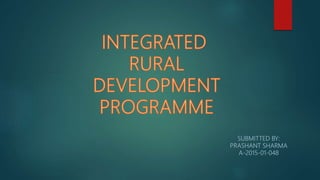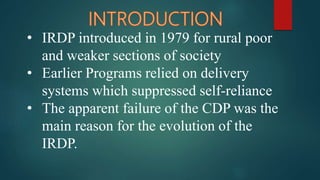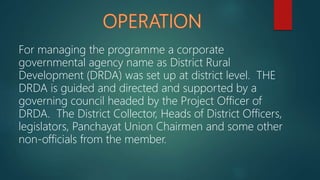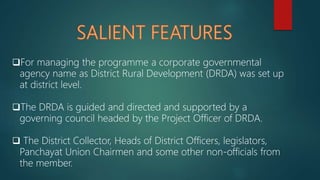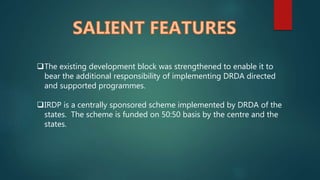Integrated Rural Development Programme
- 2. ŌĆó IRDP introduced in 1979 for rural poor and weaker sections of society ŌĆó Earlier Programs relied on delivery systems which suppressed self-reliance ŌĆó The apparent failure of the CDP was the main reason for the evolution of the IRDP.
- 3. ’ü▒To provide gainful employment and increase the purchasing power of rural poor. ’ü▒The job opportunities must be provided through the application of science and technology in making optimum use of existing local resources. ’ü▒The programme must be simple enough to operate and be economically viable to ensure quick self-reliance of its beneficiaries.
- 4. For managing the programme a corporate governmental agency name as District Rural Development (DRDA) was set up at district level. THE DRDA is guided and directed and supported by a governing council headed by the Project Officer of DRDA. The District Collector, Heads of District Officers, legislators, Panchayat Union Chairmen and some other non-officials from the member.
- 5. ’ü▒For managing the programme a corporate governmental agency name as District Rural Development (DRDA) was set up at district level. ’ü▒The DRDA is guided and directed and supported by a governing council headed by the Project Officer of DRDA. ’ü▒ The District Collector, Heads of District Officers, legislators, Panchayat Union Chairmen and some other non-officials from the member.
- 6. ’ü▒The existing development block was strengthened to enable it to bear the additional responsibility of implementing DRDA directed and supported programmes. ’ü▒IRDP is a centrally sponsored scheme implemented by DRDA of the states. The scheme is funded on 50:50 basis by the centre and the states.
- 7. The resources provided were inadequate in majority of the cases There were large number of over dues due to one reason or the other Poor quality of assets provided to the beneficiaries in many cases The follow up of the beneficiaries was inadequate Delay in provision of assets and preliminary high costs incurred by beneficiaries Lack of training facilities to farmers
- 8. delay in releasing subsidy bribes taken by various functionaries concerned very inadequate supporting facilities or services non-availability of loans for making capital lack of guidance about insurance cover.
